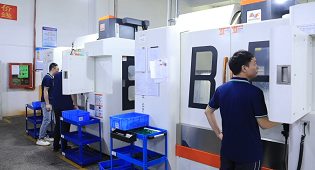Machining Parts Processing Sequence
To meet the design accuracy requirements of the parts, the processing sequence arrangement should follow certain principles.
1) Rough first, fine later
The processing sequence of each surface is roughing, semi-finishing, finishing and finishing to gradually improve the precision and surface quality of the machined surface of parts. Suppose CNC machine tools process all the surfaces of the parts. In that case, the working procedure is generally arranged in the order of roughing, semi-finishing, and finishing. That is, the roughing is completed and then semi-finishing and finishing. Roughing can quickly remove most of the machining allowance and then finish each surface, in turn, to improve production efficiency and ensure the machining accuracy and surface roughness of parts.
This method is suitable for machining surfaces with high position accuracy. This is not absolute, such as for some higher dimensional accuracy requirements of the machining surface, taking into account the stiffness of parts, deformation, and dimensional accuracy requirements can also consider these machining surfaces according to rough machining, semi-finishing, and finishing order to complete. For high precision processing of the surface, in the rough, finishing process between the parts, the best use of a period, so that the rough parts after the surface stress is fully released, reduce the surface of the parts of the stress deformation degree, which is conducive to improve the machining accuracy of parts.
2) Datum first processing principle
Precision machining parts, in the beginning, is always used for finishing the surface of the benchmark processing out, because the surface of the locating datum precisely, the clamping error is small, so any parts processing, always the positioning surface roughing and semi-finishing, precision even when necessary, for example, axial parts constantly locating datum for roughing and semi-finishing, precision work again.
For example, axis parts are always processed center hole first, then the center hole surface and positioning hole as sound benchmark processing hole system and other surfaces. Suppose there is more than one precise datum. In that case, the processing of the datum should be arranged according to the sequence of datum conversion and the principle of gradually improving the processing accuracy.
 |
| CNC machining company |
3) Face before hole principle
For box type, bracket type, body type, and other parts, the plane contour size is more significant, with the plane positioning being more stable and reliable, so it should be processed on the first plane after processing holes.
In this way, not only does the subsequent processing have a stable and reliable plane as a positioning datum, but also, in the smooth surface of the hole processing, processing becomes more straightforward and conducive to improving the machining accuracy of the hole. Usually, according to the parts of the processing parts of the process, generally the first processing of simple geometric shapes, after processing complex geometric shapes; First CNC machining parts with lower accuracy, and then machining parts with higher accuracy; First processing plane, after processing holes.
4) Position the datum again
after the first principle for the precision sleeve, its alignment with the cylindrical hole, the demand is higher, generally based on the principle of the cylindrical hole before, that is beyond the first round hole as locating datum processing, again with the bore as positioning reference of high precision machining cylindrical, so we can ensure that the cylindrical and has high alignment requirements between holes, and use the fixture structure is simple.
Instant Quotes for CNC MachiningParts: https://www.tuofa-cncmachining.com/


评论
发表评论